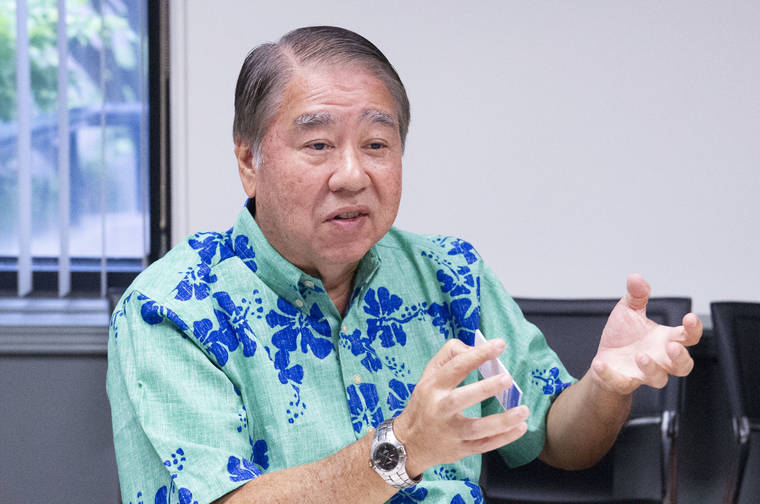Gradual lifting of Hawaii’s lockdown could start in a month

CRAIG T. KOJIMA / JULY 17
Mark Mugiishi, president and CEO of the Hawaii Medical Service Association, announced the reopening timetable Monday.
Certain places in Hawaii closed to curtail COVID-19 could begin to reopen within a month.
However, lifting restrictions that have crushed the state economy is expected to be a gradual process that takes place at different times for different parts of the state, establishments and industries.
Mark Mugiishi, president and CEO of the Hawaii Medical Service Association, announced the projected timetable Monday as a member of a new team assembled to devise and execute the reopening plan.
“Our current timeline is aggressive, but it’s necessary for it to be aggressive,” Mugiishi said Monday during a state House Select Committee on COVID-19 Economic and Financial Preparedness meeting.
The announcement was made on a day when just four new COVID-19 cases — the smallest addition in two months — were reported in Hawaii, and more residents are clamoring for life to return closer to normal after enduring coronavirus suppression measures that have displaced more than 250,000 people from work, suppressed tourism almost completely and shuttered schools through the summer.
Mugiishi said the leadership team to produce Hawaii’s reopening plan was just formed and met for the first time Monday.
Don't miss out on what's happening!
Stay in touch with breaking news, as it happens, conveniently in your email inbox. It's FREE!
Team members include representatives of state government, health care industry leaders and others from the private sector who will work closely with county leaders and national experts.
The first task is to draft work plans this week for screening, testing, tracking and quarantining the population after benchmarks for reduced transmission of the novel coronavirus have been met and restrictions are lifted.
Two weeks from now, plans should be finalized and ready for implementation after a feedback and revision process that includes community engagement.
Mugiishi and others on the team are not yet forecasting which types of businesses or places would likely reopen first.
A gradual reopening is projected to start within a month at certain places, maybe parks or restaurants hypothetically, and expand as capacity for screening, testing and monitoring grows, Mugiishi said. He also said reopening is envisioned on different islands at different times.
This strategy would produce a phased restart for Hawaii’s economy that can begin quicker, as opposed to a wholesale jump-start that would take longer to safely produce.
Mugiishi said the gradual approach is necessary because obtaining resources, including COVID-19 test kits and contact-tracing manpower, to carry out screening, testing, tracking and quarantining will take time to scale up given constrained supplies of materials and trained individuals.
“This requires massive amounts of people, process, technology and policy to operationalize,” he said.
For example, Mugiishi said the state’s current capability to do about 500 daily tests might need to grow to 2,000 to sufficiently test close contacts of COVID-19 cases when restrictions are lifted.
A bigger team to handle contact tracing also would need to be ready to contain any new outbreaks. Currently, the state Department of Health has about 30 volunteers doing this work, which typically involves contacting 15, 20 or more people per case.
Determining how travelers to Hawaii will be treated also is a complicated issue that could involve U.S. Customs, the federal Transportation Security Administration and state Department of Transportation.
A national guideline for allowing restrictions to be lifted includes a “downward trajectory” of COVID-19 cases over two weeks, which parts of Hawaii can claim to have achieved. But new regulations to keep the virus from proliferating again need to be in place first.
Gov. David Ige said he understands the frustration of people, including protesters who demonstrated Sunday on Oahu, who want stay-at-home and work-at-home restrictions lifted now given Hawaii’s low rate of COVID-19 cases and deaths.
“We’ve seen the decline in business activity, and the impacts it’s had with Hawaii going from one of the states with the lowest unemployment rates to the state with the highest unemployment rate, really, in the span of four to six weeks,” he said Monday during a briefing. “We want to — when the conditions are right — be able to restore to some normalcy activity in our community.”
Ige also warned the public that reenacting restrictions might be necessary to address any spike in COVID-19 cases after the reopening process begins.
“This is a long-term challenge,” he said. “We will have to live with COVID-19 in our community for a long time.”
Alan Oshima, former Hawaiian Electric president and CEO, appointed by Ige two weeks ago to lead the state’s recovery effort, also said he wishes the team could move faster.
“We’re moving as fast as we can,” he said Monday. “This has to be a soft opening of our state, not one for all.”
Oshima said the team is looking at best existing or emerging practices in other countries, and has connected with leaders in California, Oregon and Washington.
HMSA is using its analysts and other resources to help drive the planning work, Mugiishi added.
Other people on the team include Ige, state House Speaker Scott Saiki, state Senate President Ron Kouchi, Queen’s Health Systems CEO Jill Hoggard Green, Hawaii Pacific Health CEO Ray Vara and Mary Boland, dean of the University of Hawaii School of Nursing and Dental Hygiene. Two bank CEOs also are on the team: Bob Harrison of First Hawaiian Bank and Peter Ho of Bank of Hawaii.



